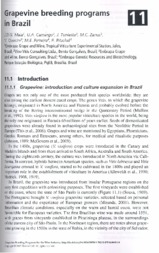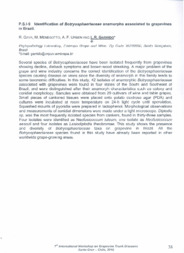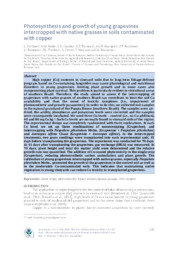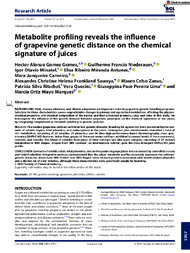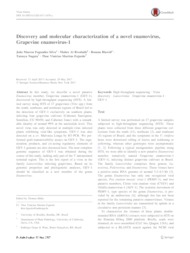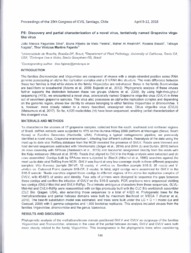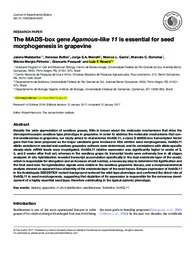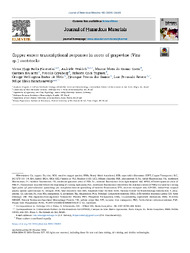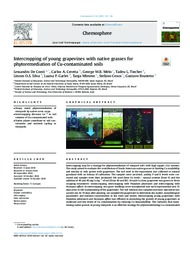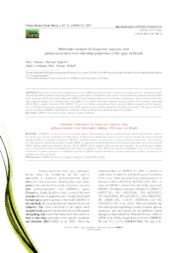Search Publications
Filter by:
| Author(s): MAIA, J. D. G.; CAMARGO, U. A.; TONIETTO, J.; ZANUS, M. C.; QUECINI, V.; FERREIRA, M. E.; RITSCHEL, P. S.
|
| Author(s): GAVA, R.; MENEGOTTO, M.; URBEN, A. F.; GARRIDO, L. da R. Several species of Botryosphaeríaceae have been isolated frequently from grapevines showing decline, dieback symptoms and brown-wood streaking. A major problem of the grape and wine industry concerns... ... |
| Author(s): DE CONTI, L.; MELO, G. W. B. de; CERETTA, C. A.; TAROUCO, C. P.; MARQUES, A. C. R.; NICOLOSO, F. T.; TASSINARI, A.; TIECHER, T. L.; CESCO, S.; MIMMO, T.; BRUNETTO, G. High copper (Cu) contents in vineyard soils due to long-term foliage-defense program based on Cu-containing fungicides may cause physiological and nutritional disorders in young grapevines, limiting p... ... |
| Author(s): GOMEZ, H. A. G.; NIEDERAUER, G. F.; MINATEL, I. O.; ANTUNES, E. R. M.; CARNEIRO, M. J.; SAWAYA, A. C. H. F.; ZANUS, M. C.; RITSCHEL, P. S.; QUECINI, V.; LIMA, G. P. P.; MARQUES, M. O. M. Yield, disease tolerance, and climate adaptation are important traits in grapevine genetic breeding programs.Selection for these characteristics causes unpredictable changes in primary and specialized... ... |
| Author(s): SILVA, J. M. F; RWAHNIH, M. A.; BLAWID, R.; NAGATA, T.; FAJARDO, T. V. M. In this study, we describe a novel putative Enamovirus member, Grapevine enamovirus-1 (GEV-1), discovered by high-throughput sequencing (HTS). A limited survey using HTS of 17 grapevines (Vitis spp.)... ... |
| Author(s): SILVA, J. M. F.; PEREIRA, B. R. de M.; AI RWAHNÍH, M.; BLAWID, R.; NAGATA, T.; FAJARDO, T. V. M. The families Bromoviridae and Virgaviridae are composed of viruses with a single-stranded positive sense RNA genome possessing an alpha-like replication complex and a 3'-t-RNA-like structure. |
| Author(s): MALABARBA, J.; BUFFON, V.; MARIATH, J. E. A.; GAETA, M. L.; DORNELAS, M. C.; MARGIS-PINHEIRO, M.; PASQUALI, G.; REVERS, L. F. Despite the wide appreciation of seedless grapes, little is known about the molecular mechanisms that drive the stenospermocarpic seedless-type phenotype in grapevine. In order to address the molecula... ... |
| Author(s): FIORENTINI, V. H. R.; WAIRICH, A.; COSTA, M. M. do C.; BRUNETTO, G.; GRYNBERG, P.; TOGAWA, R. C.; MELO, G. W. B. de; SANTOS, H. P. dos; REVERS, L. F.; RICACHENEVSKY, F. K. Copper (Cu) is an essential element for plants, participating in photosynthesis, oxidative metabolism and cell wall synthesis. However, excessive Cu may become toxic, as Cu participates in Fenton chem... ... |
| Intercropping of young grapevines with native grasses for phytoremediation of Cu-contaminated soils. Author(s): DE CONTI, L.; CERETTA, C. A.; MELO, G. W. B. de; TIECHER, T. L.; SILVA, L. O. S.; GARLET, L. P.; MIMMO, T.; CESCO, S.; BRUNETTO, G. Intercropping may be a strategy for phytoremediation of vineyard soils with high copper (Cu) content. The study aimed to evaluate the contribution of South American native grasses in limiting Cu avail... ... |
| Author(s): FAJARDO, T. V. M.; KIN, A. C.; NICKEL, O. Grapevine rupestris stem pitting-associated virus (GRSPaV) is one of the most common viruses of grapevine. It is involved in the graft-transmissible disease rupestris stem pitting of the rugose wood c... ... |
Observation
Some of Embrapa's publications are published as ePub files. To read them, use or download one of the following free software options to your computer or mobile device. Android: Google Play Books; IOS: iBooks; Windows and Linux: Calibre.
Access other publications
Access the Agricultural Research Database (BDPA) to consult Embrapa's full library collection and records.
Visit Embrapa Bookstore to purchase books and other publications sold by Embrapa.

